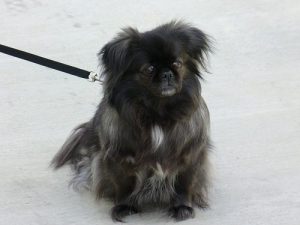The History Of The Breed
The Pekingese originated in Peking, now known as Beijing. This breed could only be owned by Chinese royalty and was regarded as semi-devine. People without nobel rank were required to bow to these canines. In 1860, the British took over the Chinese Imperial Palace. Chinese guards were ordered to kill the dogs so they would not fall into the hands of the “foreign devils.” Five Pekinese survived and were given to Queen Victoria. It is from these five that the modern day Pekingese descended. The “Peke” were also known as the Lion-Dog due to their resemblance to Chinese guardian lions.
Breed Description
The Peke is a small, compact canine. The body is muscular with a large head, in proportion to the rest of the body. The front of the face is flat. The  Peke’s muzzle is flat and broad. The nose is black and is short and broad. The eyes are large and prominent, set wide apart with black rims. The legs are short, thick and heavy boned. The tail is set high and curves over the back. Ears are heart-shaped and lay flat against the head. The outer coat is long and course in texture with much feathering. The undercoat is soft and thick. The coat comes in many colors with the most common being ream, black, white, sable, black and tan and occasionally blue or slate grey. The latter colored coats often have poor pigment and light eyes. Some may have a black mask. The Peke can weigh 8 to 10 pounds and be 6 to 9 inches tall. They can live from 10 to 15 years.
Peke’s muzzle is flat and broad. The nose is black and is short and broad. The eyes are large and prominent, set wide apart with black rims. The legs are short, thick and heavy boned. The tail is set high and curves over the back. Ears are heart-shaped and lay flat against the head. The outer coat is long and course in texture with much feathering. The undercoat is soft and thick. The coat comes in many colors with the most common being ream, black, white, sable, black and tan and occasionally blue or slate grey. The latter colored coats often have poor pigment and light eyes. Some may have a black mask. The Peke can weigh 8 to 10 pounds and be 6 to 9 inches tall. They can live from 10 to 15 years.
Grooming
A Pekingese requires daily combing and brushing of its long coat. Extra care must be taken with the hindquarters as this area can become matted. They need to be dry shampooed regularly. The face and eyes need to be cleaned daily. Check their feet for burrs and objects that can get stuck there. A Peke is an average shedder.
Personality & Care
An ideal companion for a Pekingese is a senior, single, apartment dweller or coach potato. They do well in apartments and do not require a lot of exercise. Chances are, if they are left on the coach, they will still be there hours later. They do need a daily walk and will enjoy a free run in a safe, secure area. Pekes love to bark and bark and bark. This breed will sound the alarm should a stranger come near. They do not do well in extreme heat, so it is important to keep them cool in order to prevent heat stroke.
Photo: Courtesy of Sonja McAllister via Flickr (CC BY-ND 2.0)









